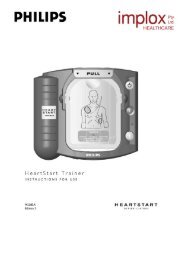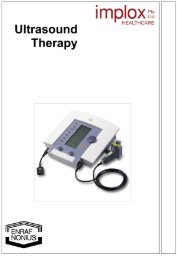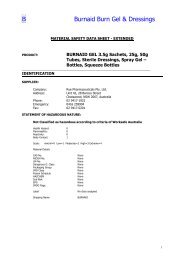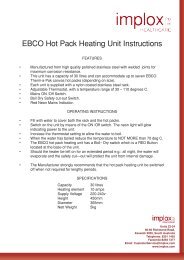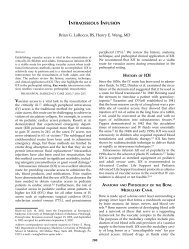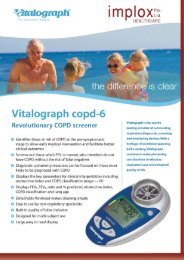Low and medium Frequency Electrotherapy - Implox
Low and medium Frequency Electrotherapy - Implox
Low and medium Frequency Electrotherapy - Implox
Create successful ePaper yourself
Turn your PDF publications into a flip-book with our unique Google optimized e-Paper software.
4 MUSCLE STIMULATION<br />
4.1 Introduction<br />
In physiotherapy, muscle contractions may be artificially induced for various objectives. The contractions can be<br />
induced with the aid of intermittent direct current, or with alternating current.<br />
A distinction should be made between objectives in the case of normally innervated muscles, <strong>and</strong> objectives where<br />
there is partial or complete denervation of the muscle fibres. This distinction is also of importance for the choice of<br />
current type(s).<br />
The physiotherapeutic objectives may be:<br />
• increasing muscle tone;<br />
• improving circulation;<br />
• muscle strengthening;<br />
• restoration of feeling in the muscle (e.g. following surgery);<br />
• relaxation of the musculature;<br />
• investigating the response to electrical stimulation of motor neurons <strong>and</strong> muscle tissue;<br />
• combatting atrophy <strong>and</strong> preventing fibrosis of muscle tissue;<br />
• stretching musculature to increase the range of movement of a joint.<br />
This chapter is concerned with the application of intermittent direct currents, <strong>and</strong> discusses both the diagnostic <strong>and</strong><br />
the therapeutic possibilities of muscle stimulation.<br />
Section 4.3 is concerned with single stimulation by means of rectangular <strong>and</strong> triangular pulses. The relationship<br />
between the two pulse types is shown in the strength/duration curve.<br />
Section 4.4 discusses (neo)faradic current as a method for multiple stimulation by means of rectangular pulses.<br />
Alternating currents (<strong>medium</strong>-frequency <strong>and</strong> TENS currents) are often applied with therapeutic objectives, <strong>and</strong> will<br />
be considered in Chapter 5.<br />
4.2 Muscle stimulation with intermittent direct current<br />
The term ‘muscle stimulation’ is used to refer to the production of a contraction in a muscle or muscle group by the<br />
application of an electrical stimulus. The objective is to assess the response to electrical stimulation of the peripheral<br />
motor neurons <strong>and</strong> the muscle tissue. Depending on the nature of the contraction that can be produced by means of<br />
direct current pulses, a distinction is made between single <strong>and</strong> multiple stimulation. In single stimulation, a single<br />
contraction is produced. Multiple stimulation leads to tetanic contraction. With respect to the pulse type, only<br />
rectangular <strong>and</strong> triangular pulses are of interest in muscle stimulation.<br />
4.3 The strength/duration curve<br />
4.3.1 Diagnostics<br />
The diagnostic objective of muscle stimulation is to obtain information on the sensitivity of the neuromuscular<br />
apparatus to electrical stimulation. This, in turn, gives an indication of the degree of denervation of the muscle tissue.<br />
In this investigation technique the relation between the current amplitude (I) <strong>and</strong> phase (pulse) time of a rectangular<br />
<strong>and</strong> triangular pulse is expressed graphically in the strength/duration curve. Although some knowledge of the basic<br />
principles of electrophysiology is required, the strength/duration curve is not difficult to make.<br />
It involves observing the current amplitude required at various phase times (ranging from 0.01 to 1000 ms) in order to<br />
produce a just perceptible (i.e. just visible or palpable) contraction of a muscle or muscle group. The values observed<br />
can be plotted as points on special logarithmic graph paper.<br />
The curve is created by joining the plotted points (Fig. 29).<br />
In the case of reduced or absent sensitivity to electrical stimulation, the strength/duration curve also gives <strong>and</strong><br />
indication of the pulse form, phase time <strong>and</strong> amplitude of the electrical stimulus to be used in any therapy that may be<br />
applied.<br />
24





